Christmas time - Is the green of the tree a Christian symbol?
- Written by Portal Editor
Now it's back, the pre-Christmas season with the Advent wreath made of fir green and the four candles, whose light enchants the Sunday breakfast table so romantically. First one, then two, then three, then four... that's what the popular saying goes.
And now the time has come for the Christmas tree, which, depending on your personal taste, will decorate the living room with balls and tinsel for the coming weeks. And then everyone swarms out looking for the right tree. No wonder, because in addition to the still current, real "Christmas trees", there is a wide range of species and varieties that are offered today. Even the plastic variant is widespread. The question remains, where does this custom actually come from?
Liberation of man from original sin
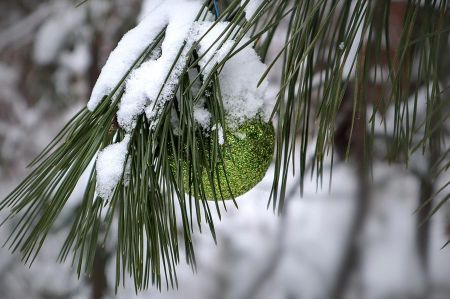 The research doesn't reveal any really historically verifiable beginnings or origins; all that's clear is that even the earliest cultures brought "green" into their homes. Evergreen plants give the impression of vitality, health and energy. Even in the Mithras cult, people decorated trees with ribbons and flags at the winter solstice to pay homage to the sun god.
The research doesn't reveal any really historically verifiable beginnings or origins; all that's clear is that even the earliest cultures brought "green" into their homes. Evergreen plants give the impression of vitality, health and energy. Even in the Mithras cult, people decorated trees with ribbons and flags at the winter solstice to pay homage to the sun god.
The ancient Romans used laurel branches not to "crown" a sporting winner but also to decorate their houses at the turn of the year. Further north, fir branches were hung in the house to make it more difficult for evil spirits to enter and at the same time to give more expressive hope for the return of spring.
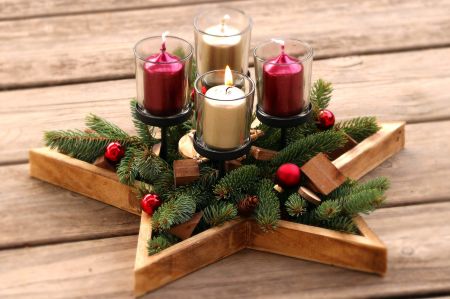 Customs are known from the Middle Ages, some of which are still carried out in our modern times or which have been revived, for example decorating the maypole or erecting the topping-out pole. At Christmas, paradise plays were performed in the church because December 24th used to be the liturgical day of remembrance of Adam and Eve, on which a paradise tree, which could also be a deciduous tree, was hung with apples. The apple served as a symbol of the forbidden fruit from the tree of knowledge and was a reminder of the fall of man and the liberation of man from original sin through Jesus Christ. Until the 19th century, people in northern Germany decorated their Christmas trees with Adam and Eve and a snake made of wood or pastries.
Customs are known from the Middle Ages, some of which are still carried out in our modern times or which have been revived, for example decorating the maypole or erecting the topping-out pole. At Christmas, paradise plays were performed in the church because December 24th used to be the liturgical day of remembrance of Adam and Eve, on which a paradise tree, which could also be a deciduous tree, was hung with apples. The apple served as a symbol of the forbidden fruit from the tree of knowledge and was a reminder of the fall of man and the liberation of man from original sin through Jesus Christ. Until the 19th century, people in northern Germany decorated their Christmas trees with Adam and Eve and a snake made of wood or pastries.
From the fir green to the Christmas tree
 In records one often finds a date from the year 1419, when the Freiburg bakers are said to have hung a tree with various sweets, fruits and nuts, which was then given away to the children to loot on New Year's Day. However, there are no sources that could be used as clear evidence here. An entry in an account book of the Humanist Library in Schlettstadt dates from 1521: “Item IIII shillings to the forester to order the tree on Sanct Thomas day.” (“As well four shillings to the forester so that he can guard the trees from St. Thomas's Day onwards. "). However, whether this can be seen as evidence of protection against illegal felling of fir trees remains at least questionable.
In records one often finds a date from the year 1419, when the Freiburg bakers are said to have hung a tree with various sweets, fruits and nuts, which was then given away to the children to loot on New Year's Day. However, there are no sources that could be used as clear evidence here. An entry in an account book of the Humanist Library in Schlettstadt dates from 1521: “Item IIII shillings to the forester to order the tree on Sanct Thomas day.” (“As well four shillings to the forester so that he can guard the trees from St. Thomas's Day onwards. "). However, whether this can be seen as evidence of protection against illegal felling of fir trees remains at least questionable.
From 1539 there is again documentary evidence that a Christmas tree was set up in the Strasbourg Cathedral. After all, it was the guilds and clubs that put an evergreen tree in the guild houses. In a pay slip from the imperial city of Gengenbach from 1576 it is mentioned that the forester “ime Strohbach” brought a “Christmas tree to the council chambers”.
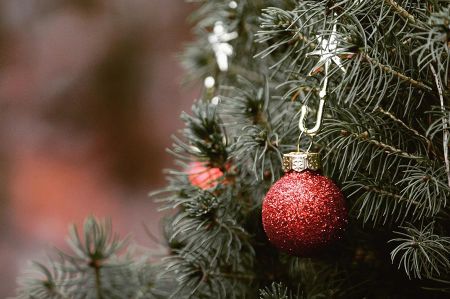 The first records of the Christmas tree as a common use come from the year 1605, again from Alsace: “At Christmas they put up trees in the rooms in Strasbourg. Horses cut out of multi-coloured paper, apples, wafers, hissing gold [thin, shaped flakes made of metal] and sugar are hanged from it. In 1611, Duchess Dorothea Sibylle of Silesia decorated the first Christmas tree with candles. The next news about the Christmas tree also comes from Strasbourg. In a writing written between 1642 and 1646, the preacher at the cathedral, Johann Conrad Dannhauer, protested against the custom of setting up Christmas trees in houses: “Among other trifles, so that one often celebrates the old Christmas season more than with God's word, is also the Christmas or a Christmas tree that you set up at home, decorate it with dolls and sugar, and then shake it off and let it bloom (clear away). I don't know where the habit comes from; is child's play."
The first records of the Christmas tree as a common use come from the year 1605, again from Alsace: “At Christmas they put up trees in the rooms in Strasbourg. Horses cut out of multi-coloured paper, apples, wafers, hissing gold [thin, shaped flakes made of metal] and sugar are hanged from it. In 1611, Duchess Dorothea Sibylle of Silesia decorated the first Christmas tree with candles. The next news about the Christmas tree also comes from Strasbourg. In a writing written between 1642 and 1646, the preacher at the cathedral, Johann Conrad Dannhauer, protested against the custom of setting up Christmas trees in houses: “Among other trifles, so that one often celebrates the old Christmas season more than with God's word, is also the Christmas or a Christmas tree that you set up at home, decorate it with dolls and sugar, and then shake it off and let it bloom (clear away). I don't know where the habit comes from; is child's play."
The Christmas tree has been moving into homes since the 18th century
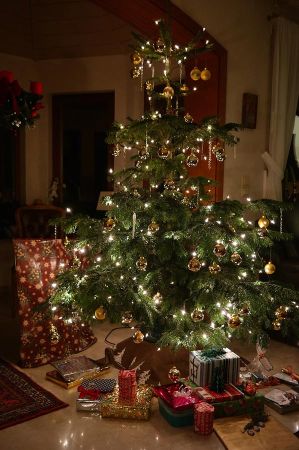 It wasn't until the first half of the 18th century that news about the Christmas tree became more common. Johann Heinrich Jung-Stilling, born in Nassau in 1740, seems to be describing a memory of his childhood when, in his "Homesickness" published in 1793, he talks about the brightly lit tree of life with gilded nuts to which the child is led on the morning of Christmas Day. speaks.
It wasn't until the first half of the 18th century that news about the Christmas tree became more common. Johann Heinrich Jung-Stilling, born in Nassau in 1740, seems to be describing a memory of his childhood when, in his "Homesickness" published in 1793, he talks about the brightly lit tree of life with gilded nuts to which the child is led on the morning of Christmas Day. speaks.
One of the first mentions of the Christmas tree in German literature comes from Johann Wolfgang von Goethe. In The Sorrows of Young Werther (1774), the protagonist visits Lotte, whom he adores, on the Sunday before Christmas and speaks of the times when the unexpected opening of the door and the appearance of a "decorated tree" with wax candles, confectionery and apples transport one to paradise delight.
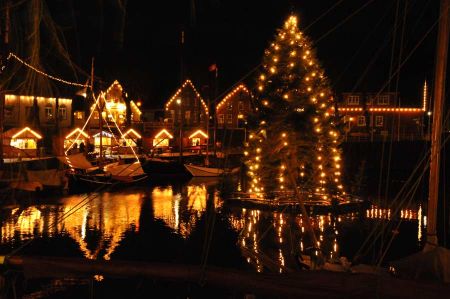 Friedrich Schiller did not depict a Christmas scene in his works, but he loved the celebration under the tree. In 1789 he wrote to Lotte that he was coming to Weimar for Christmas and said: “Hopefully you will put a green tree in my room.”
Friedrich Schiller did not depict a Christmas scene in his works, but he loved the celebration under the tree. In 1789 he wrote to Lotte that he was coming to Weimar for Christmas and said: “Hopefully you will put a green tree in my room.”
In 1805, the Christmas tree became known to a large circle of readers when Johann Peter Hebel mentioned it in the song The Mother on Christmas Eve from his Alemannic poems.
E. T. A. Hoffmann's fairy tale Nutcracker and the Mouse King from 1816 is the first Berlin literary monument in which the Christmas tree, shining with lights and decorated with golden apples and candies, appears in the middle of the Christmas presents.
Since fir trees were rare in Central Europe, only the wealthy classes could initially afford them, and the city population had to make do with branches and greenery. Only when fir and spruce forests were increasingly planted in the second half of the 19th century could urban needs be met.
The church, which owned large areas of forest, took action against the plundering of the forest at Christmas time. Over time she adopted the custom. When the Christmas tree was adopted into customs in Protestant circles, the Christmas tree began its real triumph. By the end of the 19th century, the Christmas tree was also attested in the Catholic regions of Germany and Austria.
Harvard professor Karl Follen was the first to put up a Christmas tree
 The first Christmas tree in Vienna was put up in 1814 by Fanny von Arnstein, a respected Jewish socialite from Berlin, in whose house representatives of the high nobility also came and went. As early as 1816, and according to other sources in 1823, this tradition was taken up by Henriette von Nassau-Weilburg, the wife of Archduke Charles, and from then on spread to all social classes in Austria. In 1815, the Lower Austrian state government banned “the trunking and digging up of trees for the purpose of Corpus Christi processions, church festivals, Christmas trees and the like”. “The like” probably meant the Santa Claus trees, which were described in 1782 as a “green tree decorated with burning candles, on which several pounds of candied sugar stream shine just as the ripe candied cherry tree shimmers in winter.”
The first Christmas tree in Vienna was put up in 1814 by Fanny von Arnstein, a respected Jewish socialite from Berlin, in whose house representatives of the high nobility also came and went. As early as 1816, and according to other sources in 1823, this tradition was taken up by Henriette von Nassau-Weilburg, the wife of Archduke Charles, and from then on spread to all social classes in Austria. In 1815, the Lower Austrian state government banned “the trunking and digging up of trees for the purpose of Corpus Christi processions, church festivals, Christmas trees and the like”. “The like” probably meant the Santa Claus trees, which were described in 1782 as a “green tree decorated with burning candles, on which several pounds of candied sugar stream shine just as the ripe candied cherry tree shimmers in winter.”
In 1832, German-born Harvard professor Karl Follen was the first to put up a Christmas tree in his home in Cambridge, Massachusetts, introducing the custom to New England.
 When the English Queen Victoria married Albert of Saxe-Coburg and Gotha in 1840, the Christmas tree came to London. The Netherlands, Russia, especially Petersburg and Moscow, where it was only common in the highest circles, and Italy also owe their Christmas tree to the Germans. In 1837, the Duchess Helene of Orleans introduced the Christmas tree to the Tuileries, and later the Empress Eugenie made a contribution to its distribution. Two decades later, 35,000 Christmas trees were sold in Paris.
When the English Queen Victoria married Albert of Saxe-Coburg and Gotha in 1840, the Christmas tree came to London. The Netherlands, Russia, especially Petersburg and Moscow, where it was only common in the highest circles, and Italy also owe their Christmas tree to the Germans. In 1837, the Duchess Helene of Orleans introduced the Christmas tree to the Tuileries, and later the Empress Eugenie made a contribution to its distribution. Two decades later, 35,000 Christmas trees were sold in Paris.
The Christmas tree came to North America through German emigrants and sailors. Old US newspapers report that Gustav Körner introduced the typically German custom of the illuminated and decorated Christmas tree to the USA - and this soon after arriving in the state of Illinois for his first Christmas in the USA in 1833. In the USA there were already towards the end 19th century Christmas trees made of iron.
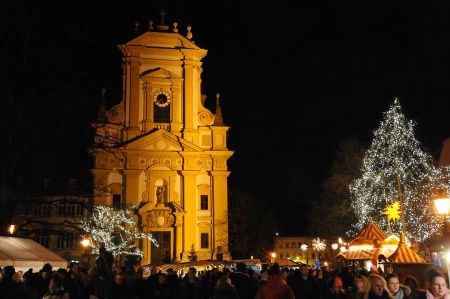 Some of these technological marvels were already lit with gas: “The gas floods through the hollow branches and where candles usually shine, the gas flame shoots up from a narrow crack.”
Some of these technological marvels were already lit with gas: “The gas floods through the hollow branches and where candles usually shine, the gas flame shoots up from a narrow crack.”
A Christmas tree was put up for the first time in St. Peter's Square in Vatican City in 1982. Likewise, every year at the start of the Christmas market, a Christmas tree is put up on Hamburg's town hall market, which is a gift from a Nordic state to the city-state.
The Christmas or Christmas tree has become established.
Please read as well:
